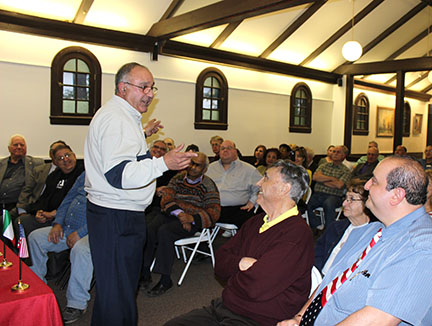THE ITALIAN AMERICAN MUSEUM OF ALBANY, NEW YORK, REMEMBERS THE ARMENIAN GENOCIDE OF 1915

Ralph Enokian from the Armenian American community spoke about the Armenian Genocide
Professor/Cavalliere Phlip J. DiNovo, president and executive director of The American Italian Heritage Association and Museum has forged a connection between Armenian Americans and Italian Americans in Albany. On May 21st, the association held an event, "The 100th Rememberance of the Armenian Genocide of 1915" at their Italian American museum. Ralph Enokian, an American of Armenian descent, and expert on the Amernian Genocide spoke to a capcity crowd at the museum. "This year marks the 100th year rememberance of the Armenan genocide," say DiNovo." My hope is other ethnic groups will make note of the Armenian Genocide." The American Italian Heritage Museum of Albany is the largest Italian American museum on the East Coast. For more information, please log on to www.americanitalianmuseum.org or email info@americanitalianmuseum.org.
Historical Background on Italian and Armenian Relations
Italians and Armernians share many attributes including a migratory status throughout much of history coupled with sincere pride over the achievements of their respective homelands.As does Italian civilization, Armenian civilization goes back many thousands of years. The first great meeting between the two cultures occurred under the dominion of the Roman Empire, which conquered part of the Armenian Kingdom in 1st Century, AD; while the other part of the Armenian Kingdom remained independent. Today, you will see remnants of Roman culture in Armenia in the way of ruins, such as temples that were erected to Roman gods many centuries ago.
In the Early Middle Ages, Italians and Armenians shared a zeal for capitalism, with a focus on international trade.Treaties were established between Armenia and Italian independent city states such as Genoa, Milan, Padua and most noteworthy Venice. One treaty brokered between Venice and Armenia allowed Italian factories to be built in Armenia in exchange for Armenian factories to be built in Venetian territory. Armenian manufactuers, merchants and workers flocked to Venice, so much so, that an island was set aside to serve their religious needs with a settlement of monks of the Mekhitarst Order. This island was named San Lazzaro degli Armeni and is today a major center for Armenian Catholicism and Armenian culture. Monks still live there and have published a variety of historical books on Armenia. The island library is today one of the largest in the world with over 150,000 volumes on Armenia and other cultures of Asia Minor and Eastern Mediterranean.
Today, estimates range between 4,000 to 5,000 Armenians living in Italy. Some Italian families were orginally from Armenia but understandably have lost touch with their cultural roots since they have lived in Italy for hundreds of years. Armenians have made a serious contribution to the betterment of Italy in a number of fields such as in medicine through the work of Giorgio Baglivi, in engineering through the work of Anton Sourian, in chemistry through the work of Giacomo Luigi Ciamician, and many more in other fields.
In 2000, Italy passed a law that made it illegal for any Italian to deny the existence of the Armenian Genocide. This past April Pope Francis addressed the Armenian genocide during Mass at Saint Peter's Basilica when he said, "In the past century, our human family has lived through three massive and unprecedented tragedies. The first, which is widely considered 'the first genocide of the 20th century,' struck your own Armenian people."

No comments:
Post a Comment